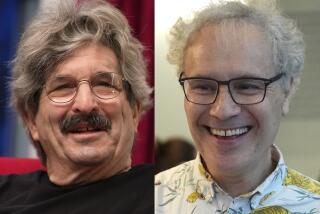Pioneering the Biomedical Future at NIH
BETHESDA, Md. — The most ambitious experiment at the National Institutes of Health today is being run out of the director’s office. Nobel laureate Harold E. Varmus can check up on it every time he looks in a mirror.
That’s because Varmus--who had never run anything larger than a gang of bright post-docs at his UC San Francisco lab--has spent the last six months trying to figure out how to manage the largest and most important biomedical research institution in the world.
As it turns out, winning a Nobel Prize is easier than winning over America’s multibillion-dollar health sciences bureaucracy.
“I’m always fighting the Defense Department mentality that if I say something, it’s supposed to happen,” says Varmus, who accepted the directorship on the non-negotiable condition that he could continue his San Francisco research in Bethesda. “I’m used to being surrounded by really smart 22-year-old students who have no problem saying that something I suggested is not a very good idea. Now I have 50-year-old section chiefs saying OK to things I say. I’m used to being contradicted by people who know that half the things I say, I’m just trying to be provocative. I have to constantly remember that whatever I say here is taken seriously.”
A brilliant experimentalist but no natural technocrat, Varmus is swiftly mapping the administrative genome of his $11-billion-a-year complex of 24 institutes and centers that, in effect, set America’s health sciences agenda. How he wants to re-engineer the NIH’s organizational DNA is still uncertain. But he brings the insights of a scientist to the task, not the sensibilities of an institution builder.
“You know, I never even had the urge to build a department,” says the lanky molecular biologist, who is far more comfortable discussing the public effect of NIH science than the Byzantine politics of NIH budgets.
The $11-billion question, however, is whether Harold Varmus will have made a greater contribution to science and public health with his Nobel-quality research or with his leadership of the NIH.
From AIDS to breast cancer to gene therapy to Alzheimer’s, it is still the NIH, rather than the giant pharmaceutical companies or the aspiring biotech start-ups, that funds the majority of basic research into the nature of disease. This research--paid for by tax dollars and conducted by hospitals and universities across the country--frequently serves as the essential source for commercial drug designs.
It is almost impossible to overstate the NIH’s influence on medical innovation. America’s leadership in biotechnology--and Varmus’ own 1989 Nobel Prize as co-discoverer of cancer-causing oncogenes--can be traced directly to the NIH’s lavish support of investigator-driven research during the 1960s, ‘70s and early ‘80s. Our Genentechs, Chirons and Biogens are all commercial offspring of NIH research, Varmus stresses. NIH research is a medical bargain.
“I keep encouraging the pharmaceutical companies to put more money into R&D;,” says an exasperated Varmus.
What do they say?
Varmus grimaces: “They say, ‘We pay taxes.’ ”
But unlike the CEOs and research vice presidents he implicitly chastises, Varmus has never had to “bet the company” on a breakthrough or try to transform an institution under extraordinary pressure. He now has his chance.
The NIH has been under intense budget pressure and public scrutiny. Congressional critics want reforms; every creative-life scientist has a pet hypothesis to test; every constituency has a disease it is desperate to cure. Varmus desperately wants more money for the institutes, but he’s not going to get it.
“Our biggest single theme is trying to make the NIH work better with the same amount of money,” he says.
Given the astonishing rise of biotechnology and America’s balance of trade leadership in global medical markets, you might think Varmus would try to position the NIH under the banner of industrial competitiveness as a way to attract additional funding. Yet “that has not been the forward argument,” he acknowledges.
Expect that to change. In fact, expect circumstances to make Varmus far more aggressive in encouraging new kinds of research relationships between the NIH, academe and industry.
“We’re not interested in giving grants to Merck,” Varmus says now. “We’re interested in giving grants to smaller business.”
But don’t be surprised if the Mercks and DuPonts are brought into research consortia as Varmus’ budget constraints drive him to create coalitions that can attract commercial grants as well as fiscal support on Capitol Hill. As Varmus notes, only five years ago most of his graduate students went on to jobs in academe. Today, “over half of them are taking jobs in industry.”
You can also expect Varmus--a scientist of global prominence--to become more vocal about encouraging foreign financial support for the institutes. No country on Earth has a biomedical establishment even a fraction the size of the NIH; the entire world relies on the fruits of its funding.
There is no question that the European Union and the growing economies of Asia need to be persuaded to be more active collaborators in the global battle against disease. Varmus will spend more time overseas than his predecessors if he hopes to snag an extra $300 million or $400 million in research funding.
But for now, Varmus the scientist is focusing on how science is done at the NIH. He’s revamping the institutes’ internal research programs--which take up about 11% of the NIH’s budget. He’s also pushing a re-evaluation of peer review, the mechanism for determining the grant-worthiness of research funding requests.






